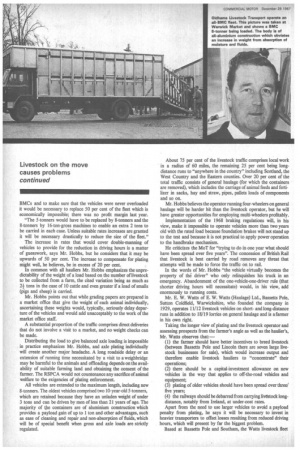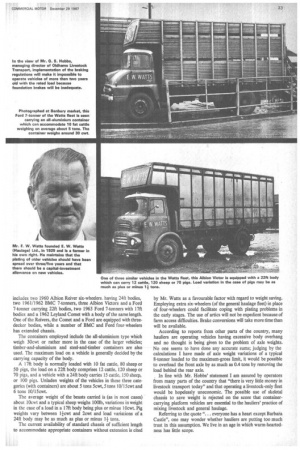BMCs and to make sure that the vehicles were never
Page 34

Page 35

If you've noticed an error in this article please click here to report it so we can fix it.
overloaded it would be necessary to replace 50 per cent of the fleet which is economically impossible; there was no profit margin last year.
"The 5-tonners would have to be replaced by 8-tonners and the 8-tonners by 16-ton-gross machines to enable an extra 2 tons to be carried in each case. Unless suitable rates increases are granted it will be necessary drastically to reduce the size of the fleet."
The increase in rates that would cover double-manning of vehicles to provide for the reduction in driving hours is a matter of guesswork, says Mr. Hobbs, but he considers that it may be upwards of 50 per cent. The increase to compensate for plating might well, he believes, be in excess of 20 per cent.
In common with all hauliers Mr. Hobbs emphasizes the unpredictability of the weight of a load based on the number of livestock to be collected from a farm, the cited variation being as much as 2tons in the case of 10 cattle and even greater if a load of smalls (pigs and sheep) is carried.
Mr. Hobbs points out that while grading papers are prepared in a market office that give the weight of each animal individually, ascertaining these weights would, typically, seriously delay departure of the vehicles and would add unacceptably to the work of the market office staff.
A substantial proportion of the traffic comprises direct deliveries that do not involve a visit to a market, and no weight checks can be made.
Distributing the load to give balanced axle loading is impossible in practice emphasizes Mr. Hobbs, and axle plating individually will create another major headache. A long roadside delay or an extension of running time necessitated by a visit to a weighbridge may be harmful to the animals and offloading depends on the availability of suitable farming land and obtaining the consent of the farmer. The RSPCA would not countenance any sacrifice of animal welfare to the exigencies of plating enforcement.
All vehicles are extended to the maximum length, including new 8-tonners. The oldest vehicles comprised two 10-year-old 5-tonners, which are retained because they have an unladen weight of under 3 tons and can be driven by men of less than 21 years of age. The majority of the containers are of aluminium construction which provides a payload gain of up to 1 ton and other advantages, such as ease of cleaning and repair and non-absorption of fluids, which will be of special benefit when gross and axle loads are strictly regulated. About 75 per cent of the livestock traffic comprises local work in a radius of 60 miles, the remaining 25 per cent being longdistance runs to "anywhere in the country" including Scotland, the West Country and the Eastern counties. Over 20 per cent of the total traffic consists of general haulage (for which the containers are removed), which includes the carriage of animal feeds and fertilizer in sacks, hay and straw, pipes, pallets loads of components and so on.
Mr. Hobbs believes the operator running four-wheelers on general haulage will be harder hit than the livestock operator, but he will have greater opportunities for employing multi-wheelers profitably.
Implementation of the 1968 braking regulations will, in his view, make it impossible to operate vehicles more than two years old with the rated load because foundation brakes will not stand up to the test and because it is not practical to apply power operation to the handbrake mechanism.
He criticizes the MoT for "trying to do in one year what should have been spread over five years". The concession of British Rail that livestock is best carried by road removes any threat that attempts will be made to force the traffic on to rail.
In the words of Mr. Hobbs "the vehicle virtually becomes the property of the driver" who only relinquishes his truck in an emergency. Abandonment of the one-vehicle-one-driver rule (that shorter driving hours will necessitate) would, in his view, add enormously to running costs.
Mr. E. W. Watts of E. W. Watts (Haulage) Ltd., Bassetts Pole, Sutton Coldfield, Warwickshire, who founded the company in 1929, operates 11/12 livestock vehicles on shortand long-distance runs in addition to 18/19 lorries on general haulage and is a farmer in his own right.
Taking the longer view of plating and the livestock operator and assessing prospects from the farmer's angle as well as the haulier's, Mr. Watts observes that:— (1) the farmer should have better incentives to breed livestock (between Bassetts Pole and Lincoln there are seven large livestock businesses for sale), which would increase output and therefore enable livestock hauliers to "concentrate" their operations; (2) there should be a capital-investment allowance on new vehicles in the way that applies to off-the-road vehicles and equipment; (3) plating of older vehicles should have been spread over three/ five years; (4) the railways should be debarred from carrying livestock longdistance, notably from Ireland, at under-cost rates.
Apart from the need to use larger vehicles to avoid a payload penalty from plating, he says it will be necessary to invest in heavier transporters to offset losses resulting from reduced driving hours, which will present by far the biggest problem.
Based at Bassetts Pole and Southgun, the Watts livestock fleet includes two 1960 Albion Reiver six-wheelers. having 24ft bodies, two 1961/1962 EMC 7-tonners, three Albion Victors and a Ford 7-tonner carrying 22ft bodies, two 1963 Ford 7-tonners with 17ft bodies and a 1962 Leyland Comet with a body of the same length. One of the Reivers, the Comet and a Ford are equipped with threedecker bodies, while a number of BMC and Ford four-wheelers has extended chassis.
The containers employed include the all-aluminium type which weigh 30cwt or rather more in the case of the larger vehicles; timber-and-aluminium and steel-and-timber containers are also used. The maximum load on a vehicle is generally decided by the carrying capacity of the body.
A 17ft body is normally loaded with 10 fat cattle, 80 sheep or 50 pigs, the load on a 22ft body comprises 12 cattle, 120 sheep or 70 pigs, and a vehicle with a 24ft body carries 15 cattle, 150 sheep, or 100 pigs. Unladen weights of the vehicles in these three categories (with containers) are about 5 tons 5cwt, 5 tons 10/15cwt and 6 tons 10/15cwt.
The average weight of the beasts carried is (as in most cases) about lOewt and a typical sheep weighs 100lb, variations in weight in the case of a load in a 17ft body being plus or minus lOcwt. Pig weights vary between 1.-1,-cwt and 2cwt and load variations of a 24ft body may be as much as plus or minus 1+ tons.
The current availability of standard chassis of sufficient length to accommodate appropriate containers without extension is cited by Mr. Watts as a favourable factor with regard to weight saving. Employing extra six-wheelers (of the general haulage fleet) in place of four-wheelers could facilitate coping with plating problems in the early stages. The use of artics will not be expedient because of farm access difficulties. Brake conversions will take more time than will be available.
According to reports from other parts of the country, many hauliers are operating vehicles having excessive body overhang and no thought is being given to the problem of axle weights. No one seems to have done any accurate sums; judging by the calculations I have made of axle weight variations of a typical 8-tonner loaded to the maximum-gross limit, it would be possible to overload the front axle by as much as 0.4 tons by removing the load behind the rear axle.
. In line with Mr. Hobbs' statement I am assured by operators from many parts of the country that "there is very little money in livestock transport today" and that operating a livestock-only fleet would be hopelessly uneconomic. The possible use of skeletal chassis to save weight is rejected on the score that containercarrying platform vehicles are essential to the hauliers' practice of mixing livestock and general haulage.
Referring to the quote ". .. everyone has a heart except Barbara Castle", one may wonder whether hauliers are putting too much trust in this assumption. We live in an age in which warm-heartedness has little scope.












































































